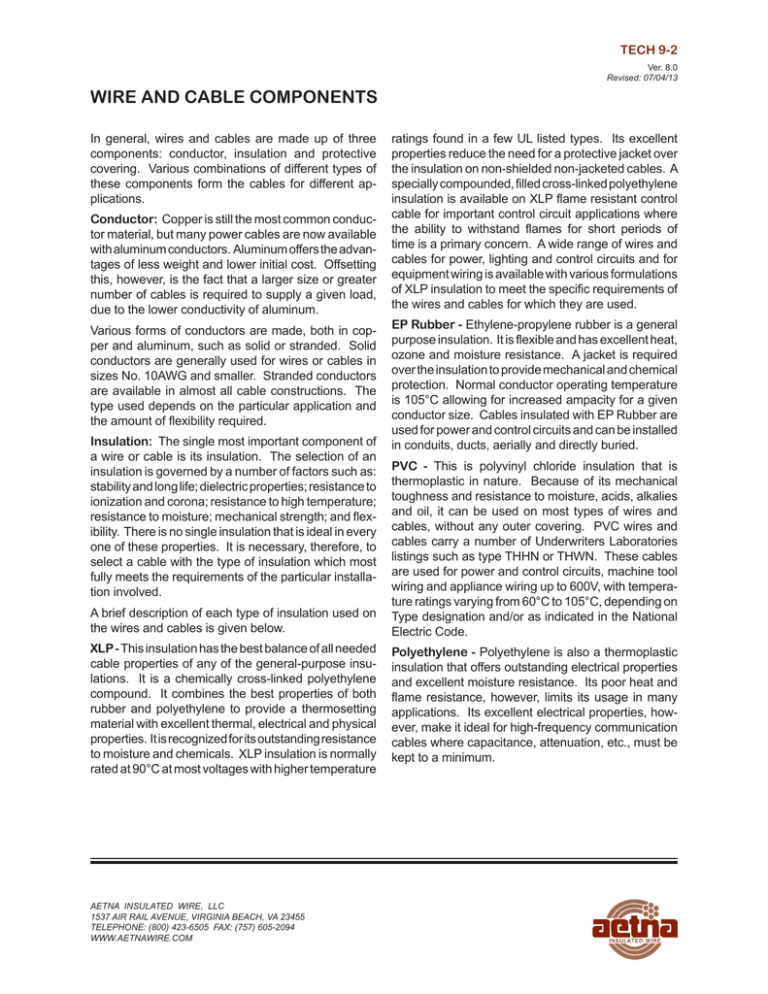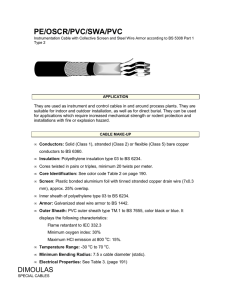wire and cable components - Aetna Insulated Wire, LLC
advertisement

TECH 9-2 Ver. 8.0 Revised: 07/04/13 WIRE AND CABLE COMPONENTS In general, wires and cables are made up of three components: conductor, insulation and protective covering. Various combinations of different types of these components form the cables for different applications. Conductor: Copper is still the most common conductor material, but many power cables are now available with aluminum conductors. Aluminum offers the advantages of less weight and lower initial cost. Offsetting this, however, is the fact that a larger size or greater number of cables is required to supply a given load, due to the lower conductivity of aluminum. Various forms of conductors are made, both in copper and aluminum, such as solid or stranded. Solid conductors are generally used for wires or cables in sizes No. 10AWG and smaller. Stranded conductors are available in almost all cable constructions. The type used depends on the particular application and the amount of flexibility required. Insulation: The single most important component of a wire or cable is its insulation. The selection of an insulation is governed by a number of factors such as: stability and long life; dielectric properties; resistance to ionization and corona; resistance to high temperature; resistance to moisture; mechanical strength; and flexibility. There is no single insulation that is ideal in every one of these properties. It is necessary, therefore, to select a cable with the type of insulation which most fully meets the requirements of the particular installation involved. A brief description of each type of insulation used on the wires and cables is given below. XLP - This insulation has the best balance of all needed cable properties of any of the general-purpose insulations. It is a chemically cross-linked polyethylene compound. It combines the best properties of both rubber and polyethylene to provide a thermosetting material with excellent thermal, electrical and physical properties. It is recognized for its outstanding resistance to moisture and chemicals. XLP insulation is normally rated at 90°C at most voltages with higher temperature AETNA INSULATED WIRE, LLC 1537 AIR RAIL AVENUE, VIRGINIA BEACH, VA 23455 TELEPHONE: (800) 423-6505 FAX: (757) 605-2094 WWW.AETNAWIRE.COM ratings found in a few UL listed types. Its excellent properties reduce the need for a protective jacket over the insulation on non-shielded non-jacketed cables. A specially compounded, filled cross-linked polyethylene insulation is available on XLP flame resistant control cable for important control circuit applications where the ability to withstand flames for short periods of time is a primary concern. A wide range of wires and cables for power, lighting and control circuits and for equipment wiring is available with various formulations of XLP insulation to meet the specific requirements of the wires and cables for which they are used. EP Rubber - Ethylene-propylene rubber is a general purpose insulation. It is flexible and has excellent heat, ozone and moisture resistance. A jacket is required over the insulation to provide mechanical and chemical protection. Normal conductor operating temperature is 105°C allowing for increased ampacity for a given conductor size. Cables insulated with EP Rubber are used for power and control circuits and can be installed in conduits, ducts, aerially and directly buried. PVC - This is polyvinyl chloride insulation that is thermoplastic in nature. Because of its mechanical toughness and resistance to moisture, acids, alkalies and oil, it can be used on most types of wires and cables, without any outer covering. PVC wires and cables carry a number of Underwriters Laboratories listings such as type THHN or THWN. These cables are used for power and control circuits, machine tool wiring and appliance wiring up to 600V, with temperature ratings varying from 60°C to 105°C, depending on Type designation and/or as indicated in the National Electric Code. Polyethylene - Polyethylene is also a thermoplastic insulation that offers outstanding electrical properties and excellent moisture resistance. Its poor heat and flame resistance, however, limits its usage in many applications. Its excellent electrical properties, however, make it ideal for high-frequency communication cables where capacitance, attenuation, etc., must be kept to a minimum. TECH 9-2 Ver. 8.0 Revised: 07/04/13 WIRE AND CABLE COMPONENTS (CONTINUED) Protective Coverings: These are applied over a wire or cable insulation for either mechanical, chemical or electrical reasons, or all. It is not uncommon for a wire or cable to have several types of protective coverings to meet the requirements of a particular application. Some of the more common are discussed in the following paragraphs. a) Armor: Interlocked armor offers excellent mechanical protection and is mostly made of galvanized steel, or aluminum, depending upon installation requirements. For applications where interlocked armor cable is to be installed in a corrosive atmosphere, it is available with an overall extruded jacket. Continuously welded and corrugated armor offers the advantage of creating a completely gas and vapor tight protective covering to the cable core. This means that the armor or sheath is completely impervious to liquids or gases and as such can be used in Class 1 Div 1 installations. b) Synthetic Compounds: PVC jackets provide protection from oils, acids and alkalies and are resistant to moisture, gasoline and flame. While they are lower in cost than neoprene, they are not as flexible nor as able to withstand high temperatures. LSHF (low smoke halogen free) jacket material has excellent flame retardancy and is lead free and halogen free. In addition it has superior mechanical strength and exhibits good resistance to most chemicals including oil and fuel. CPE (chlorinated PE) is similar to the LSOH but is somewhat stiffer and the fire performance is somewhat less. In addition, the CPE jacket does have some amount of leads, halogens and does release more toxins than the LSOH when burning. LLDPE (linear low density PE) are relatively tough jackets with low moisture permeability. However they are poor performers with respect to flammability. LLDPE jacket are widely used for underground distribution cables. AETNA INSULATED WIRE, LLC 1537 AIR RAIL AVENUE, VIRGINIA BEACH, VA 23455 TELEPHONE: (800) 423-6505 FAX: (757) 605-2094 WWW.AETNAWIRE.COM

